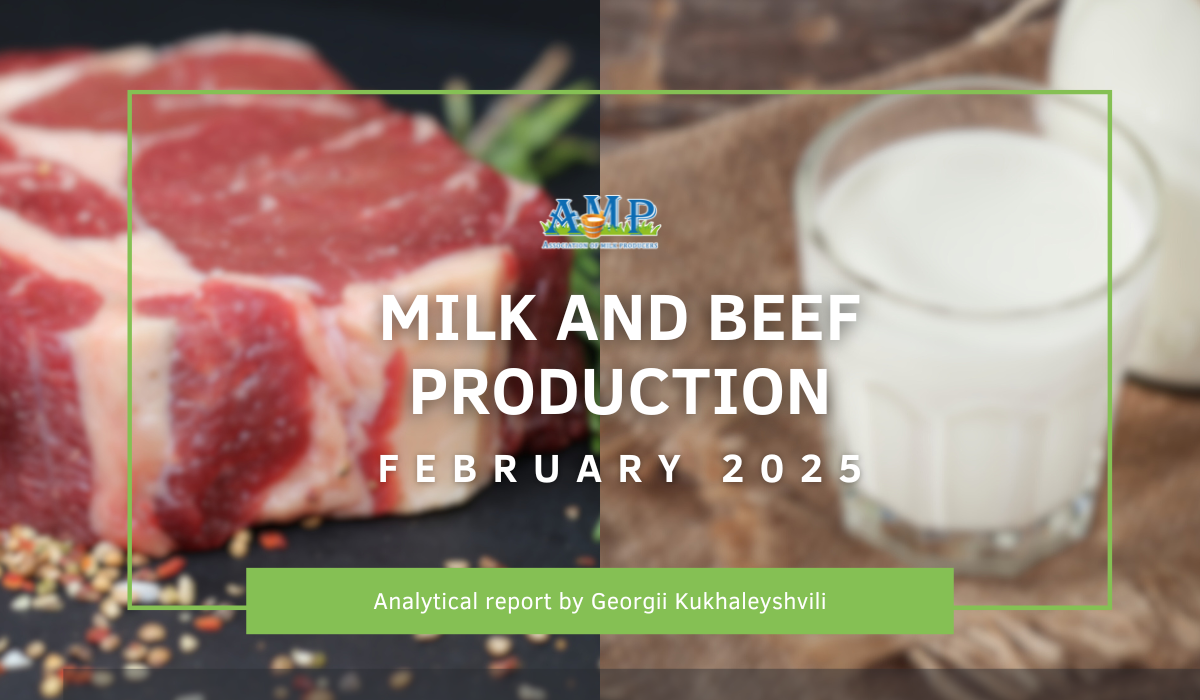Dairy farms (DFs) may refrain from significantly increasing milk production in 2025 to prevent further drops in raw milk prices, reports Georgii Kukhaleishvili, an analyst at the Association of Milk Producers of Ukraine (AMP).
According to preliminary data from the Ministry of Agrarian Policy, in February 2025, farms of all categories produced 439,000 tons of raw milk, which is 14,000 tons less (-3%) compared to January 2025 and 24,000 tons less (-5%) than in February 2024. In January-February 2025, milk production in Ukraine amounted to 891,000 tons, which is 32,000 tons (-4%) less than during the same period last year. In February 2025, enterprises accounted for 55% of raw milk production, while households contributed 45%.
Enterprises (industrial dairy farms) produced 239,000 tons of raw milk in February 2025, which is 20,000 tons less (-8%) compared to January 2025 and 4,000 tons more (+2%) than in February 2024. In January-February 2025, DFs produced 499,000 tons of raw milk, which is 21,000 tons (+4%) more compared to the same period last year.
In households, milk production in February 2025 amounted to 200,000 tons, which is 6,000 tons more (+3%) than in January 2025 and 28,000 tons less (-12%) compared to February 2024. In January-February 2025, the household sector produced 393,000 tons of raw milk, which is 53,000 tons (-12%) less than during the same period last year.
Georgii Kukhaleishvili notes that in 2025, DFs may hold off on increasing milk production due to declining demand for dairy products in the domestic market and falling procurement prices. Since dairy processing enterprises cannot purchase milk at adequate market prices, further increases in milk yields could lead to even greater price collapses. A challenge for Ukraine's dairy industry is the potential threat of foot-and-mouth disease outbreaks recorded in Hungary and Slovakia. Increased culling of infected livestock may result in reduced milk production volumes.
There are prospects for a slight increase in milk demand in Ukraine. Dairy processing enterprises aim to stimulate demand for dairy products among the population through discounts and promotional offers in retail chains. With the arrival of spring, the ice cream season begins, and exports of canned dairy products from Ukraine are increasing, which drives additional raw milk volumes for processing.
Milk production volumes saw the most significant increases at agricultural enterprises in the following regions compared to last year:
- Lviv Region (+21%)
- Mykolaiv Region (+19%)
- Khmelnytskyi Region (+13%)
- Ternopil Region (+12%)
- Chernivtsi Region (+15%)
- Vinnytsia Region (+8%)
- Rivne Region (+8%)
- Zhytomyr Region (+7%)
- Poltava Region (+6%)
- Ivano-Frankivsk Region (+4%)
- Cherkasy Region (+4%).
In February 2025, around 50% of raw milk production was accounted for by agricultural enterprises in the following regions:
- Poltava Region – 99.3 thousand tons
- Khmelnytskyi Region – 86.4 thousand tons
- Vinnytsia Region – 78.4 thousand tons
- Cherkasy Region – 70.9 thousand tons
- Chernihiv Region – 57.3 thousand tons
- Zhytomyr Region – 54 thousand tons.
Beef Production:
According to preliminary estimates by the Ministry of Agrarian Policy, in February 2025, cattle slaughter volumes amounted to 10,200 tons, which is 4,000 tons less (-26%) than in January 2025 and 900 tons less (-8%) than in February 2024. In January-February 2025, slaughter volumes in Ukraine totaled 24,000 tons, which is 1,000 tons (-4%) less compared to the same period last year. In February 2025, enterprises accounted for 61% of total cattle slaughter, while households contributed 39%.
According to preliminary data from the Ministry of Agrarian Policy, in February 2025, cattle slaughter volumes at enterprises amounted to 6,200 tons, which is 1,000 tons less (-13%) than in January 2025 and 300 tons less (-5%) than in February 2024. In January-February 2025, slaughter volumes at agricultural enterprises totaled 13,300 tons, which is 300 tons (+2%) more compared to the same period last year.
In households, cattle slaughter volumes in February 2025 amounted to 4,000 tons, which is 3,000 tons less (-40%) than in January and 1,000 tons less (-13%) than in February 2024. In January-February 2025, slaughter volumes in households reached 10,700 tons, which is 1,300 tons (-11%) less compared to the same period last year.
The total slaughter volumes of agricultural animals, including not only cattle but also pigs, sheep, and poultry, amounted to 504,100 tons in January-February 2025, which is 4% less compared to the same period last year.
Preliminary data for February 2025 indicates the most significant increases in slaughter volumes at agricultural enterprises in the following regions compared to last year:
- Zakarpattia Region (+240%)
- Zaporizhzhia Region (+80%)
- Mykolaiv Region (+64%)
- Kharkiv Region (+48%)
- Chernivtsi Region (+48%)
- Khmelnytskyi Region (+21%)
- Lviv Region (+14%)
- Kirovohrad Region (+13%)
- Odesa Region (+13%)
- Ivano-Frankivsk Region (+10%)
- Chernihiv Region (+9%)
- Rivne Region (+7%)
- Ternopil Region (+2%).
The highest slaughter volumes of animals at agricultural enterprises in February 2025 were recorded in the following regions:
- Vinnytsia Region – 111,600 tons
- Cherkasy Region – 71,900 tons
- Dnipropetrovsk Region – 62,400 tons
- Lviv Region – 34,300 tons.
Press Service of the Association of Milk Producers
Follow us on Facebook
Related News


